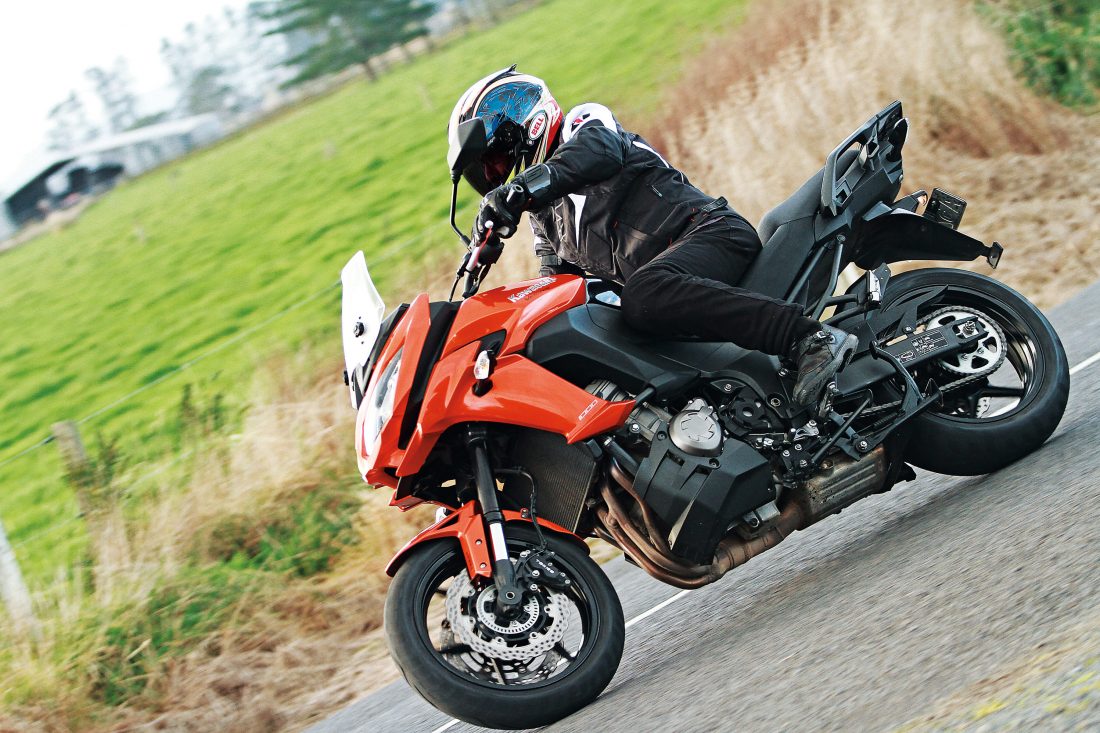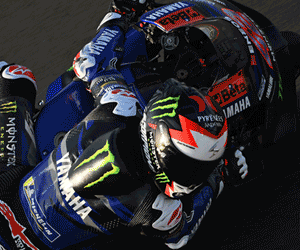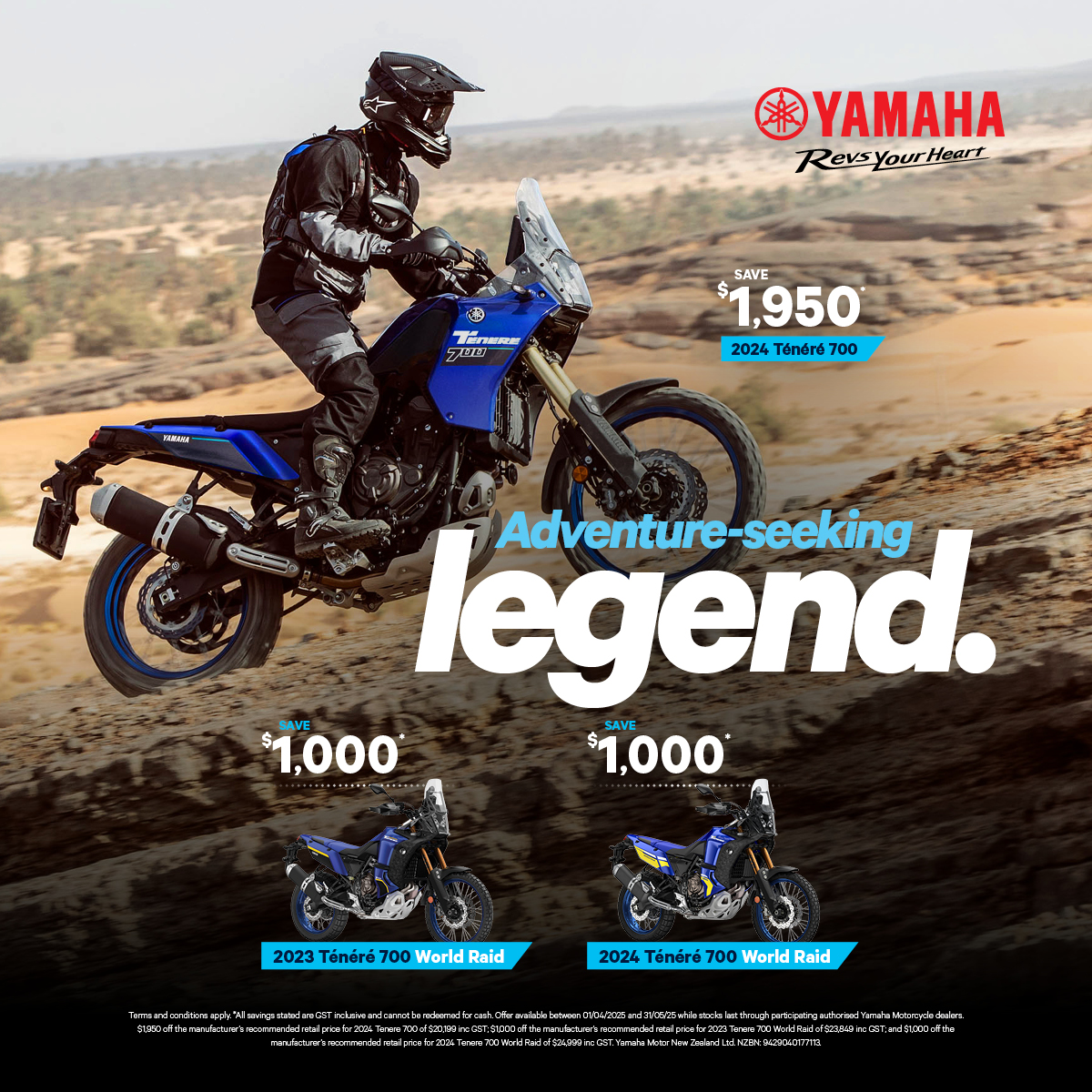Kawasaki Versys 1000
Old School Cool
Words & pics: Paul
Better looks, stellar motor and gentleman manners; the Versys 1000 is largely updated for 2015 but still manages to slip under the radar. We spent a couple of weeks with the Kawasaki and discovered that ‘Versys’ really is an abbreviation of versatile…
Maybe it’s because the Versys doesn’t fit into one particular mould that it seems to get over-looked. It’s not an adventure bike as the 17” wheels, snug front mudguard and lack of a duckbill front certainly show, but it does have long travel suspension and optional luggage which can swallow enough for a weekend away (just maybe not a trip round the world…). It could be a tourer as it’s all-day comfortable, but then the sleek bodywork kind of ruins that idea, and it’s pretty close to a sportsbike with the 1,043cc powerplant making enough horses to keep you in touch with (and more likely ahead of) your sportsbike riding mates. In fact, the Versys could tick the box as suiting any of these genres, and it may well be that’s just where the ‘problem’ lies.
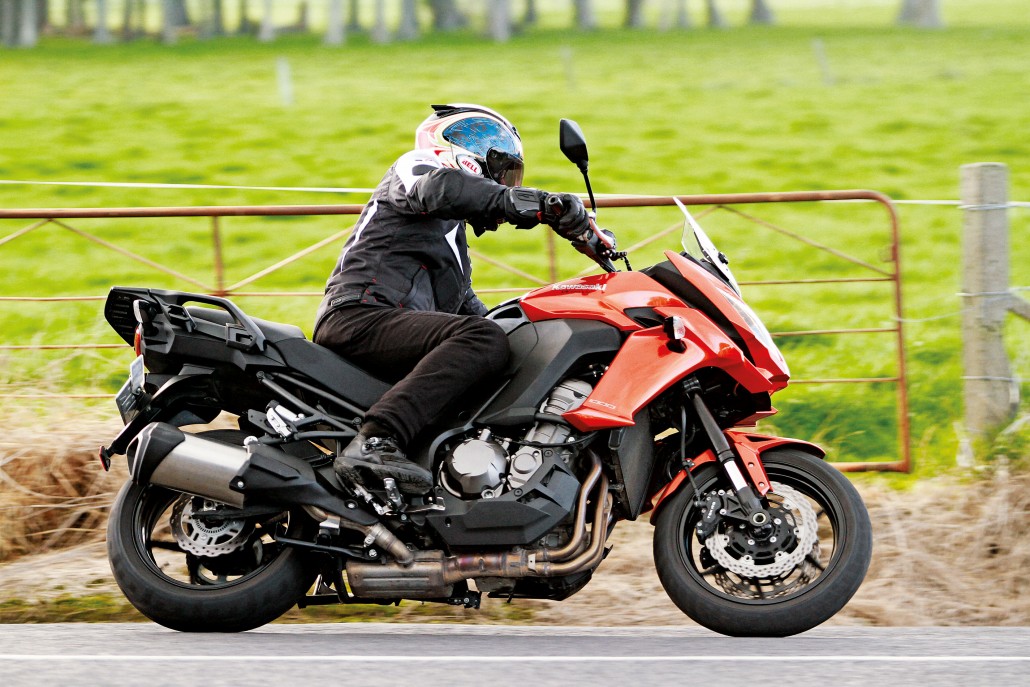 Motherly Love
Motherly Love
The Versys range has been available for eight years in 650cc parallel-twin form, which uses the extremely successful ER6n as its donor and then the model we’re testing here, the Versys 1000, which has been around since 2012 – closely related to the stunning Z1000SX. We loved the SX when we tested it, with the powerplant providing plenty of entertainment no matter the situation, while the rest of the bike provided a comfortable and sensible if somewhat sporty package.
The Versys takes the comfort side of things a step further, with Kawasaki labelling the Versys as ‘dual sport’ in some markets. I’d say that’s stretching the genre a bit far, but if you can class a Porsche as an SUV, then I guess you can understand where Kawasaki are coming from.
The original Versys, although great motorcycles, didn’t do themselves any favours with having a face that, really, only a mother or a true Kawasaki stalwart could love. Whichever way you looked at it, they were an ugly bike. The new version has given the Versys the looks it deserves, making a great bike look modern and imposing but almost harking back to the old school days of the original Z1000 and its stacked exhausts. The technology also has that traditional feel, with the aluminium twin-tube frame combine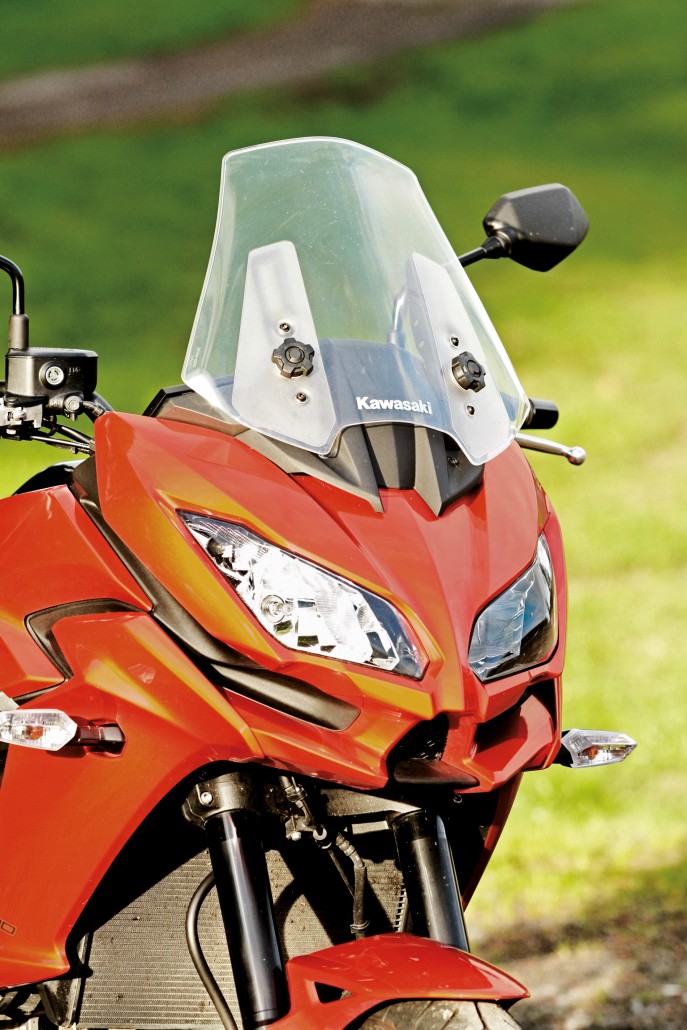 d with the long 150mm of suspension travel giving the Versys a certain amount of movement through the bends. It’s nothing dramatic, but without any of the modern-day electronic suspension trickery that’s available on some of the alternative bikes out there, it’s a case of finding a set-up with the clickers that covers all bases. It’s what we’ve done for years and despite not being able to firm the Versys up with a push of a button, it’s a confident and predictable bike when the pace hots up.
d with the long 150mm of suspension travel giving the Versys a certain amount of movement through the bends. It’s nothing dramatic, but without any of the modern-day electronic suspension trickery that’s available on some of the alternative bikes out there, it’s a case of finding a set-up with the clickers that covers all bases. It’s what we’ve done for years and despite not being able to firm the Versys up with a push of a button, it’s a confident and predictable bike when the pace hots up.
The stepped saddle also harks back, with the riding position particularly sit-in, the 840mm seat height making the Versys a viable choice for those not particularly endowed in the leg department. If you take a pillion on a regular basis, they’re going to love the Versys, as the rear perch is sculpted to avoid the passenger sliding forward and there’s plenty of padding and a decent grab rail to hold on to.
And they certainly need to hold on, with engines being something that Kawasaki always do well and the Versys is no exception. Open the taps on the 38mm Keihin throttle bodies and despite the Versys ‘only’ having 120hp, it benefits from 102Nm of torque meaning it drives forward from almost zero revs in any gear and continues to pull till the 10,000rpm redline. With lots of bikes requiring lots of revs and plenty of cog swapping to get the most out of the performance, the Versys is a breath of fresh air and, again, has that old school feel of bikes when they had carbs and riders had big balls.
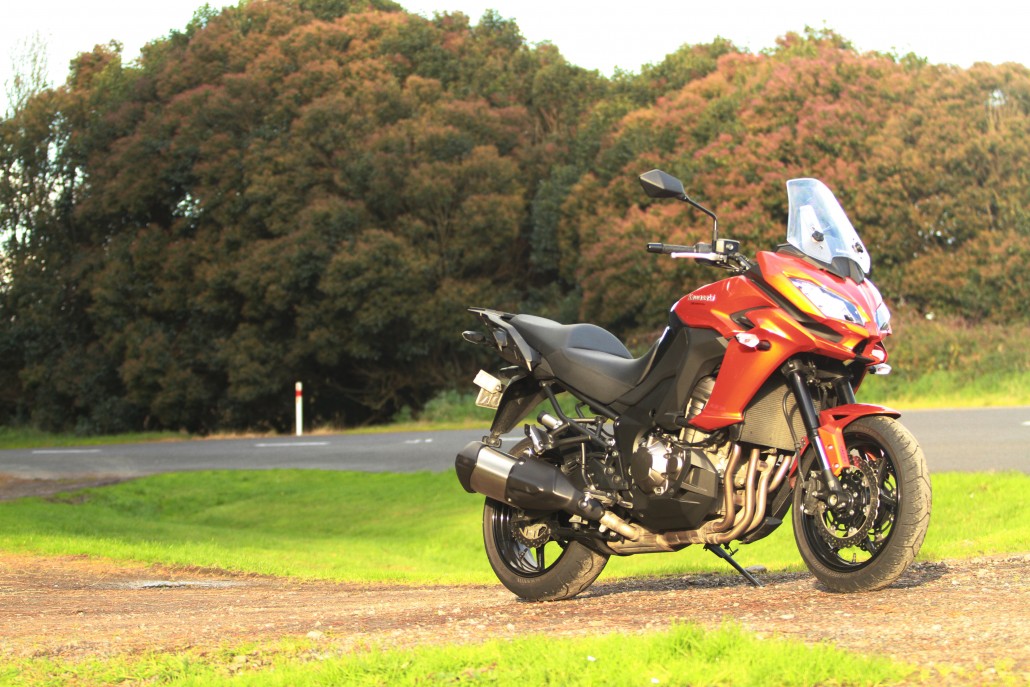 Modern World
Modern World
It’s not all simple technology though, with a decent anti-lock braking package keeping the Tokico calipers from locking the 310mm wavy front discs, while a sophisticated 3-mode traction control system keeps an eye on the rear-wheel. Settings 1 and 2 don’t interfere with forward momentum too much, and the Versys will even still lift the front wheel under power without the system shutting the drive down as happens on so many other bikes. Setting 3 is for extremely slippery conditions with maximum intervention, plus the system can be turned off altogether, which again, isn’t always an option on other models. The engine’s performance can also be dialled down using the power mode selection option, with delivery able to be switched between full or low power while on the move. Full power is so much fun, it’s almost addictive. But should the conditions get a bit tricky or maybe you’re looking to conserve the remaining fuel you have left in the tank while trying to reach a service station, then a flick to low power sees the output limited to around 75% and the throttle response tamed down. Turn the traction control up to 3 and the power mode to low and the Versys becomes a pussycat that shouldn’t give any surprises.
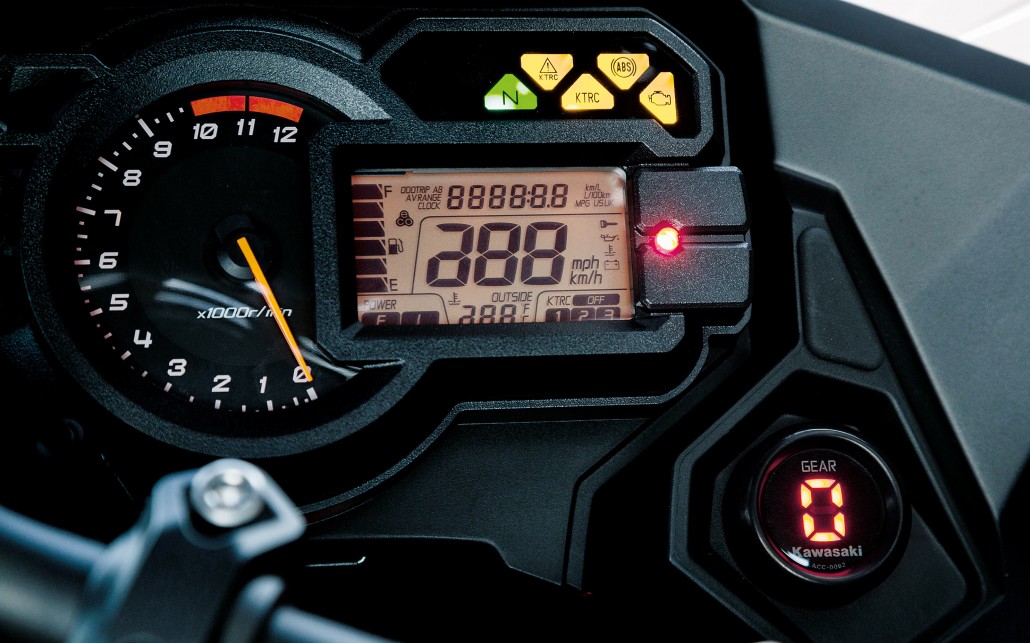 With many bikes almost needing a degree in computers to operate them, the dash on the Versys is a pleasant combination of traditional and modern, with the analogue tacho adjoined by an LCD screen. It’s there you can instantly see the power and traction control settings, both of which are adjusted via a toggle switch on the bars. It’s easy to use which actually encourages you to switch between modes during a ride depending on conditions, your pace and what type of road you’re heading down. The speed you’re travelling is also easy to distinguish with a quick glance, while a fuel gauge let’s you know how much more fun you’re going to be having before being forced to stop for a top up.
With many bikes almost needing a degree in computers to operate them, the dash on the Versys is a pleasant combination of traditional and modern, with the analogue tacho adjoined by an LCD screen. It’s there you can instantly see the power and traction control settings, both of which are adjusted via a toggle switch on the bars. It’s easy to use which actually encourages you to switch between modes during a ride depending on conditions, your pace and what type of road you’re heading down. The speed you’re travelling is also easy to distinguish with a quick glance, while a fuel gauge let’s you know how much more fun you’re going to be having before being forced to stop for a top up.
Unfortunately, one thing that can’t be adjusted on the fly is the screen, with two knobs on the outside meaning it can be adjusted without tools, but it still requires either some very trick riding or for you to be stationary and off the bike to get the height altered. Originally only featuring 30mm of adjustment, the screen now raises or lowers a total of 75mm, giving you a decent bubble of still air when in it’s highest position. Despite being almost classed as half-faired, Kawasaki have put a lot of thought into the wind protection afforded to a Versys owner, with a chin spoiler positioned below the headlights to direct airflow around the upper cowl, while a couple of air intakes actually direct air toward the rider to reduce the effects of negative pressure from the screen which reduces buffeting. It might not look like it, but the Versys offers the rider and pillion all-day comfort without having the equivalent of a barn door mounted to the front of the motorcycle, especially with a balancer shaft, rubber-mounted pegs and bars combined with an inherently smooth powerplant making vibrations almost negligible.
As you’d expect with a motorcycle that can munch miles, the Versys is designed to accept panniers yet it doesn’t look out of place without them mounted, as is often the case. Instead, the top mounts for the panniers are combined with the serious grab handle, while the bottom of the cases slide onto the back of the rear footpegs. Panniers on or off, the Versys is a good looking machine especially in the orange colour that we had on test (well that’s our opinion anyway…)
Keeping It Real
With bikes getting lighter, faster, smaller and more technical each year, the Versys 1000 was like a breath of fresh air when I swung a leg over the saddle and fired the four-cylinder powerplant into life. It feels substantial and is undoubtedly well made. The motor is involving and provides  that feeling of a bike almost grabbing you by the scruff of the neck and dragging you up the road. It’s not all computer controlled niceties; the Versys is, dare is say it, a man’s bike that likes to be muscled and rewards accordingly. Okay, the 21litre fuel tank and decent fuel economy will mean you and your partner can travel in two-up comfort at a moderate pace for hours without needing to stop, and when you make it to your destination, you’ll be stoked to have a ‘sensible’ bike that has got you there without a drama while also delivering a considerable amount of luggage. But lose the pillion and the bags and the Versys can do the Jekyll and Hyde thing, turning into a muscle bike that loves to be thrashed and will reward you with a stunning turn of performance, massive wheelies and sharp handling. Bikes, like cars, are almost losing their character in these days of computer design, computer control and political correctness. The Versys harks back to the good old days where twisting the throttle gives you a good old-fashioned kick up the arse and a bike that lunges for the horizon. Good on you Kawasaki for reminding me just how much fun a ‘big bike’ can be…
that feeling of a bike almost grabbing you by the scruff of the neck and dragging you up the road. It’s not all computer controlled niceties; the Versys is, dare is say it, a man’s bike that likes to be muscled and rewards accordingly. Okay, the 21litre fuel tank and decent fuel economy will mean you and your partner can travel in two-up comfort at a moderate pace for hours without needing to stop, and when you make it to your destination, you’ll be stoked to have a ‘sensible’ bike that has got you there without a drama while also delivering a considerable amount of luggage. But lose the pillion and the bags and the Versys can do the Jekyll and Hyde thing, turning into a muscle bike that loves to be thrashed and will reward you with a stunning turn of performance, massive wheelies and sharp handling. Bikes, like cars, are almost losing their character in these days of computer design, computer control and political correctness. The Versys harks back to the good old days where twisting the throttle gives you a good old-fashioned kick up the arse and a bike that lunges for the horizon. Good on you Kawasaki for reminding me just how much fun a ‘big bike’ can be…
Kawasaki Versys 1000 specifications
Pricing: $17,995 ($19,995 with panniers)
| ENGINE | |
| Type Displacement Bore and Stroke Compression ratio Valve system Fuel system Lubrication |
Liquid-cooled, 4-stroke In-Line Four 1,043 cc 77.0 x 56.0 mm 10.3:1 DOHC, 16 valves Fuel injection: ø38 mm x 4 with oval sub-throttles Forced lubrication, wet sump |
| DRIVETRAIN | |
| Transmission Clutch Final drive |
6-speed, return Wet multi-disc, slipper type, manual Sealed chain |
| FRAME | |
| Type Wheel travel:Tyre:Caster (rake) Trail |
Twin-tube, aluminium 150 mm 150 mm 120/70ZR17M/C 180/55ZR17M/C 27 degrees 106 mm |
| SUSPENSION Front: TypeRear: Type |
ø43 mm inverted fork with rebound damping (right-side) and spring preload adjustabilityHorizontal Back-link, gas-charged, with rebound damping and remote spring preload adjustability |
| BRAKES Front: Type CaliperRear: Type Caliper |
Dual semi-floating ø310 mm petal discs Dual opposed 4-piston Single ø250 mm petal disc Single-piston |
| DIMENSIONS Overall length Overall width Overall height Wheelbase Ground clearance Seat height Curb Mass* Fuel capacity |
2,240 mm 895 mm 1,400 mm / 1,465 mm 1,520 mm 150 mm 840 mm 249 kg 21 litres |
| PERFORMANCE Maximum power Maximum torque |
88 kW {120 PS} / 9,000 min 102 N.m {10.4 kgf.m} / 7,500 min |

